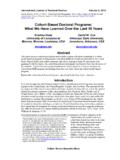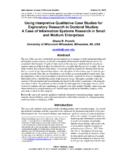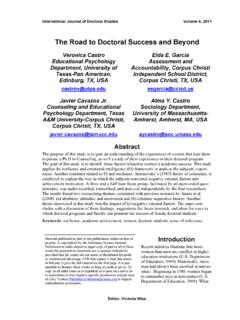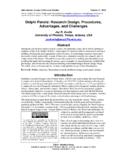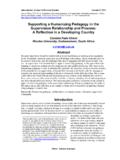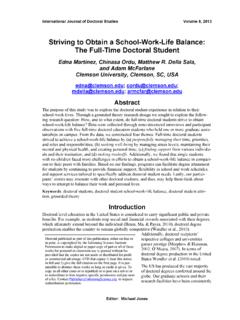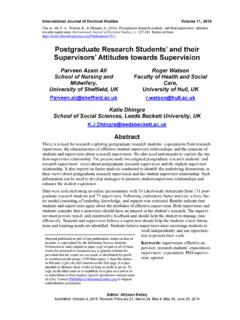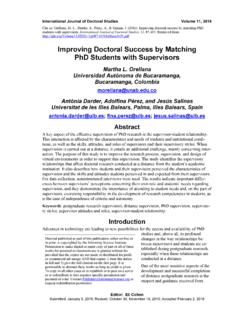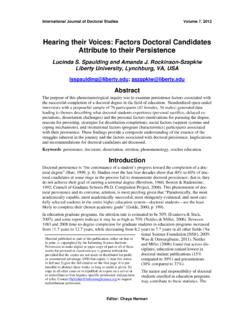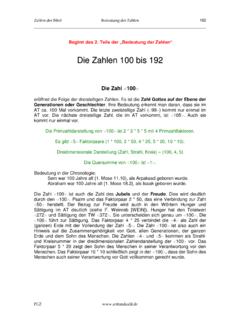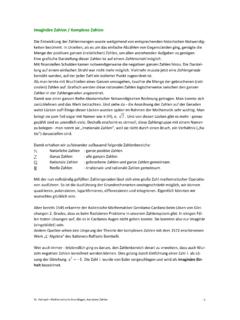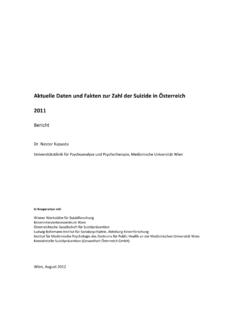Transcription of The Impact of Community for Part-Time Doctoral Students ...
1 International Journal of Doctoral Studies Volume 10, 2015. Cite as: zahl , S. B. (2015). The Impact of Community for Part-Time Doctoral Students : How relationships in the academ- ic department affect student persistence. International Journal of Doctoral Studies, 10, 301-321. Retrieved from The Impact of Community for Part-Time Doctoral Students : How Relationships in the Academic Department Affect Student Persistence Sarah B. zahl Marian University, Indianapolis, Indiana, USA. Abstract This study examines the ways that Part-Time Students develop Community within the aca- demic department and how a sense of Community is related to persistence. This study included 12. participants (ten Students and two program chairs) in two academic departments at one urban re- search institution.
2 This qualitative study followed a descriptive case study design and provided three levels of data: the institution is the bounded system; the academic departments are the cases;. and the participants are embedded cases. Positive relationships with peers and faculty served as a source of encouragement and supported persistence, particularly during challenging semesters and later phases of the Doctoral program. However, it was often difficult for the participants to develop and/or maintain relationships, due to limited proximity, limited access to faculty, and changing cohorts. Participants did not consider full-time Doctoral Students to be part of their Community , due to perceived differences between Part-Time and full-time Students .
3 The partici- pants also perceived that faculty catered to full-time Students and preferred to conduct research with them rather than Part-Time Students . Keywords: Doctoral education, Part-Time Students , Community , graduate study, persistence Introduction Projections of the number of Doctoral Students who leave their programs range from 30 to 70%. (Berelson, 1960; Council of Graduate Schools [CGS], 2008; Hawley, 2010; Lovitts, 2001; Nettles & Millett, 2006; Tinto, 1993). Despite many national programs ( , Carnegie Foundation for the Advancement of Teaching, 2008; CGS, 2008; Woodrow Wilson National Fellowship Foundation, 2005) and institutional efforts to decrease attrition of Doctoral Students , there has been little to no change in attrition rates in the past 50 years (Berelson, 1960; CGS, 2008).
4 Pursuing a as a full-time student is correlated with persistence and degree attainment (Clewell, 1987; Girves & Wemmerus, 1988; Nettles & Millett, 2006; Ott & Markewich, 1985. because full-time Students have more Material published as part of this publication, either on-line or opportunities to interact with faculty in print, is copyrighted by the Informing Science Institute. Permission to make digital or paper copy of part or all of these and peers. However, the number of part- works for personal or classroom use is granted without fee time Students pursuing Doctoral degrees provided that the copies are not made or distributed for profit continues to grow. According to the or commercial advantage AND that copies 1) bear this notice Council of Graduate Schools, approxi- in full and 2) give the full citation on the first page.
5 It is per- missible to abstract these works so long as credit is given. To mately 33% of all Students in the copy in all other cases or to republish or to post on a server or United States are enrolled Part-Time , to redistribute to lists requires specific permission and payment with some disciplines reporting numbers of a fee. Contact to request as high as 57% (CGS, 2012). Despite redistribution permission. these percentages, Part-Time Students are Editor: Ahabab Chowdury Submitted: April 24, 2014; Revised: May 5, 2014, August 7, 2015; Accepted: August 10, 2015. Impact of Community for Part-Time Doctoral Students rarely included in the literature on the Doctoral student experience (Berelson, 1960; Golde, 1998, 2005; Hawley, 2010; Lovitts, 2001; Lovitts & Nelson, 2000; Tinto, 1993; Weidman, Twale, &.)
6 Stein, 2001; White & Nonnamaker, 2008). The increasing numbers of Part-Time Doctoral Students combined with attrition rates of up to 70%. (Berelson, 1960; CGS, 2008; Hawley, 2010; Lovitts, 2001; Nettles & Millett, 2006; Tinto, 1993), warrant special attention on this population of Doctoral Students . A line of research that holds promise to improve attrition rates revolves around a sense of Community between the student and the academic department. Accordingly, this study examined the ways that Part-Time stu- dents develop Community within the academic department and how a sense of Community is re- lated to student persistence. Specifically, this study investigated two questions: 1) In what ways do Part-Time Doctoral Students develop a sense of Community within their academic departments?
7 And 2) How does a sense of Community influence the persistence of Part-Time Doctoral Students ? Literature Review Many researchers have found a strong link between attrition and a lack of Community between the student and the department of study (Antony, 2002; Lovitts, 2001; Lovitts & Nelson, 2000). A lack of interaction with faculty and peers can lead to a graduate student experience character- ized by loneliness, stress, isolation, and confusion (Gardner, 2008; Hadjioannou, Shelton, Fu, &. Dhanarattigannon, 2007; Lovitts & Nelson, 2001; Weidman et al., 2001). However, frequent pos- itive interactions produce strong connections to the department and create a system of supportive relationships (Weidman et al., 2001). Research indicates that the highest attrition rates are found in the humanities and social sciences (average ten year attrition rate of 32% (CGS, 2008)), where programs of study are typically individualized and Students are expected to conduct research in- dependently.
8 Conversely, the lowest attrition rates are in the sciences (average ten year attrition rate of (CGS, 2008)), where Students are often required to conduct collaborative research and meet regularly with laboratory groups (Baird, 1990; Deem & Brehony, 2000; Lovitts & Nel- son, 2000; Nettles & Millett, 2006). Defining Doctoral Student Community Community in educational contexts is frequently associated with foundational ideas of belonging and mattering as they relate to meaningful relationships with others and becoming a valued member of a sustained, collective group (Tinto, 1993; Wenger, 1998; White & Nonnamaker, 2008). For this study, Community is defined as the development of social networks through rela- tionships in the academic setting.
9 Kadushin (2004) defines social networks as relationships that one can draw upon as resources during graduate study. Social relationships with faculty and peers serve as important resources to assist Students in working through social, emotional, and academic problems they are likely to encounter while pursuing the doctorate (Golde, 1998, 2005;. Hawley, 2010; Lovitts, 2001; Lovitts & Nelson, 2000; Tinto, 1993; White & Nonnamaker, 2008). Tinto's Theory of Doctoral Student Persistence Tinto's (1993) book on student attrition includes a foundational model of Doctoral student persis- tence and describes Community during Doctoral study. While Tinto did not intend to explain the development of Community , this research provides a foundational lens to view social and aca- demic systems (the department) as the student's primary Community throughout graduate study.
10 Tinto's model proposes that Doctoral student persistence depends on how individuals function within social and academic systems. The extent and quality of the interactions in these systems determine the degree to which Doctoral Students become integrated and ultimately persist to complete the program. One criticism of Tinto's model and other models of Doctoral student per- sistence and socialization ( , Weidman et al., 2001) is that all Students are assumed to fit the 302. zahl model in the same way (Golde, 2000). This one size fits all approach fails to address the needs and experiences of certain groups of Students , particularly Part-Time Students . Socialization and Integration into Program Culture Socialization is widely accepted as a framework to describe the experiences and development of Doctoral Students during graduate study (Antony, 2002; Austin, 2010; Gardner, 2007; Golde, 1998, 2000; Weidman et al.)
